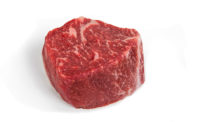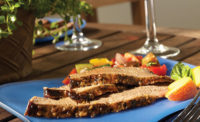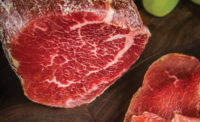Guest Commentary | Dr. Phil Bass
Bone-in beef cuts: A bone of contention

T-bones, porterhouses, cowboy ribeyes — all classic steakhouse fare found in some of those “old school,” dimly lit carnivore havens of yore. But the popularity of bone-in beef cuts has waned a great deal over the decades to the point that many restaurants offering beef steak items offer them in only the boneless form. As a result, a new spin on the steak dining experience is in fact making the older style of bone-in beef cuts a cool new movement.
Let’s take a look at what has become a very common theme in the meat community, boneless cuts. Rarely will one find a bone-in chuck roast anymore, but let’s be honest: the bone-in beef steak, with the minor exception of the T-bone and porterhouse, have become somewhat of a novelty. It simply makes sense to break the beef carcass at the packing plant into boneless cuts of beef. By boning out the side, the packer can then ship only the edible portion of the carcass and therefore more efficiently process the bones in the on-site or nearby rendering operation. As a result, the meat counters and restaurants we see today have very nicely trimmed beef (and other species as well) cuts that are ready to consume. What might be overlooked is the potentially cool look of that bone in the beef cut and the subsequent cooked presentation on the plate.
Being on the cusp of the Millennial generation, I must admit going to the grocery store with my mom while growing up allowed me to see that the majority of beef cuts in the meat case were boneless. This was contrary to the bone-in steaks in our freezer at home from the farm-raised cattle we harvested. It makes sense to offer only the edible portion of meat in the meat case. Enter the foodie movement. Foodies, especially Millennial foodies, are looking for that next cool thing. What they are also focused on is not just taste, but appearance. Take a culinary enthusiast to dinner and the first thing he or she does when the food comes out is take a picture of the gastronomic masterpiece and post it on social media. If a restaurant or home chef wants to be sure their dish makes it onto guests’ Facebook page, all they have to do is pick a cut with the bone still attached. The presentation, romance and artistry surrounding a bone-in cut of beef will wow most any contemporary fan of the culinary arts. That bit of bone adds a visual dimension that excites the inner caveman and brings the emotional tie to the cut by which we are about to devour.
But it’s not just the fashionable foodie who may be interested in taking a bite out of a bone-in cut of beef, but rather the folks who were in the meat market back when bone-in cuts were much more popular. Some of the older generations may look nostalgically at the bone-in steak. Food is a very emotional thing, and something as simple as leaving the bone in a ribeye could remind a beef lover of happy times.
What’s most incredible about this slow movement back to a bone-in steak experience is the fact that although there is a bone attached to the meat, in most cases that cut can be sold at a higher price point. Take for example a bone-in striploin steak sold to restaurants for around $13.25 a pound, versus a boneless striploin steak sold to a restaurant at $14.60 a pound. If we sell the boneless strip steak at a 12-ounce portion, that will give us a steak cost of $10.95. If we sell the same meat weight as a bone-in steak, considering the bone weighs about 2 ounces, we will have an $11.59 steak cost. Even though the steaks provide about the same edible meat portion, the bone-in costs more, yet diners tend to be willing to try it more often. Furthermore, the cost of the bone-in striploin to the steak cutter will be less than the boneless striploin as a raw input further expanding the potential profit of the bone-in option even more and it gives people what they want: coolness factor.
But does the bone add more than just visual appeal? There are several scientific peer-reviewed journal articles demonstrating no added flavor benefits to bone-in steaks; however, due to the bone acting as an insulator during cooking, there can be a slight difference in degree of doneness near the bone that can produce a perceived difference in taste. The majority of the steak will offer an eating experience similar to that of a boneless steak. This of course does not mean a bone-in steak is not worth eating — quite the contrary. The eating experience includes the opportunity to pick up the bone and gnaw from it the last bit of tasty meat morsels — not to mention a fun, hands-on, social exercise.
Bone-in beef steaks and roasts are great options for various applications. The bone-in beef cut will provide a different dimension to the plate appeal. It also will provide an option for a lower-cost item while providing a satisfying beef eating experience. To the generations that reminisce about the bone-in beef cuts or those who have not really had the chance to experience it, the excitement and romance around a bone-attached steak will help restaurants and meat counters differentiate themselves from the competition in an easily accessible, yet meaningful, way. NP
Looking for a reprint of this article?
From high-res PDFs to custom plaques, order your copy today!








